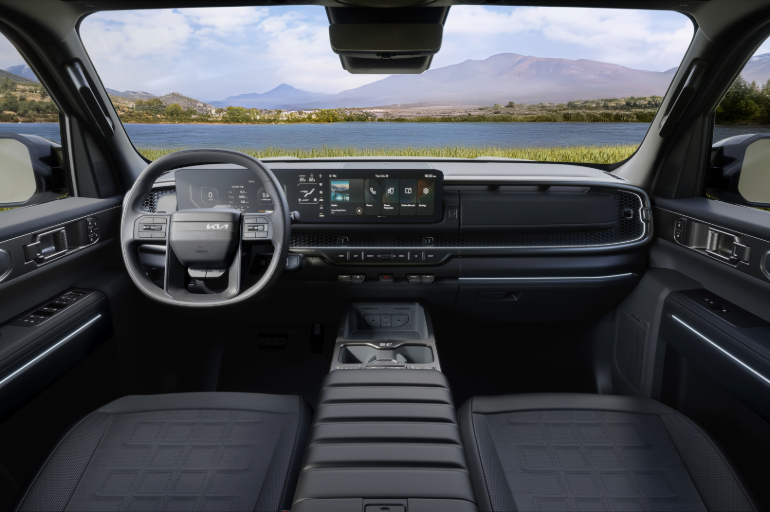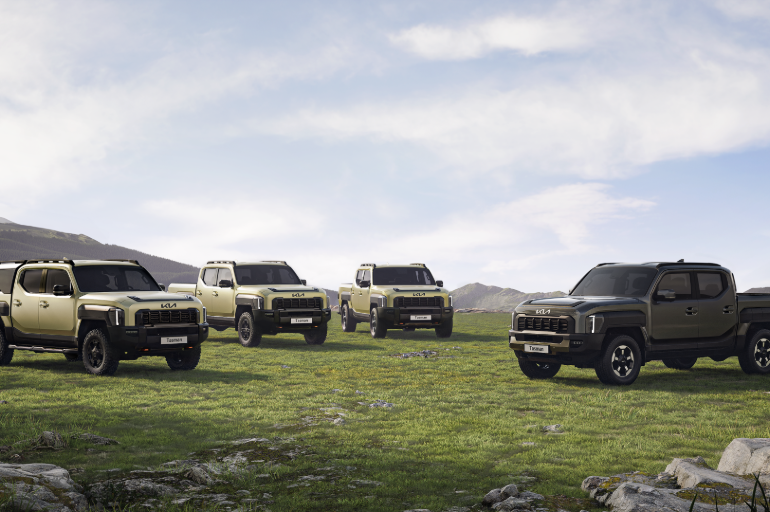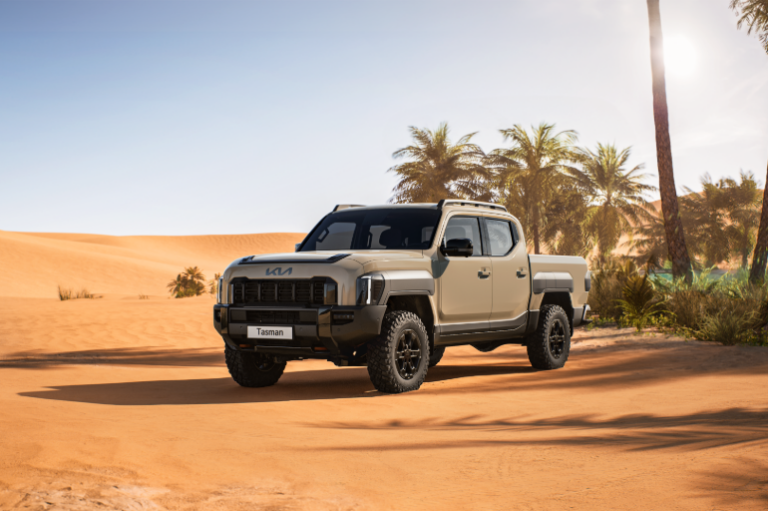Kia unveiled its Tasman ute to Australian media this week, after teasing its imminent arrival with one of the most iconic television ads in recent history, but the unusual appearance of the tray-back model has divided the internet. Does it look good, bad, or flat-out ugly?
While we’ll let you decide what you think of its futuristic looks, under the skin the Kia Tasman appears fit for work and play, with more technology and design smarts onboard than many of its established ute competitors.
“Kia’s first-ever pickup truck was created from the ground up to transform the market and respond to the growing preference for lifestyle-oriented trucks with advanced features,” said Kia President and CEO, Ho Sung Song.
“The Kia Tasman is a progressive pickup truck that follows its own path – not the competition. The Kia Tasman combines true pickup values with exceptional capability and practicality, and advanced features that defy conventional thinking. It offers world-first solutions for those seeking a lifestyle vehicle for leisure and outdoor activities while meeting the needs of small business operators, such as traders and farmers.”
According to Kia, its design team “deliberately shunned” the familiar shape and style of traditional utes, instead opting for a fresh (or ugly, depending on who you ask) aesthetic that is both futuristic and somewhat stripped back, with much of the design elements also serving a functional purpose.
Take the rear wheel arches for example, which also house storage units and the fronts which contain the headlights. While the design appears disjointed at first glance, it’s clearly well thought out.
“Created especially for explorers, adventurers and people who like to get things done, the Kia Tasman is designed to serve as a dependable companion in every situation,” said Head of Kia Global Design, Karim Habib.
“Solid and capable, its design begins with an honest form, using simple and rugged elements to capture a spirit of practicality. The Kia Tasman is a pickup truck that effortlessly blends lifestyle and utility, and represents our commitment to always bring bold and innovative ideas to our customers.”
The interior is suitably modern too, reflecting Kia’s passenger car approach to cabin layouts but borrowing cues from other ute options. An example of this is the centre console, which folds down to form a work- or lunch-ready table, much like the setup in the Ford F-150.
A focus has been placed on interior space, with second-row legroom of 940mm and the rear seats will recline to between 22 and 30 degrees when required. Storage is also significant with various bins and nooks making up a total of 33 litres of stowaway storage within the cabin.
Large panoramic screens form the infotainment system, made up of two 12.3-inch screens and a 5.0-inch display that provide control for both the driver and passenger. An eight speaker Harmon Kardon audio system and wireless smartphone connectivity round out the infotainment technology.

What we know so far is that the Kia Tasman will be sold in both dual and single-cab layouts, with a choice of three trim grades: Base, X-Line and X-Pro.
In terms of the differences, the X-Pro separates itself as a more serious off-road contender with 28mm more ground clearance, totalling an impressive 252mm (anything over 220mm is good for a dual-cab 4×4 ute). It also features more off-road suitable 17-inch gloss-black wheels with all-terrain tires, while the X-Line features larger 18-inch alloy wheels paired with highway terrain tyres.
Kia will offer cab chassis variants for fleet and trade customers wanting more customisability, with a choice of four tray options; Single Decker, Double Decker, Sports Bar and Ladder Rack. According to Kia, a range of accessories will be available at the time of launch to allow customers to kit-out their Tasman as they please – be it for work or play.
Now, the all-important question: What running gear has Kia equipped the Tasman with? The Korean market will get a petrol option, while Australian models will score a 2.2-litre diesel engine producing 154kW/441Nm, mated to an eight-speed automatic.
The X-Line and the X-Pro come with all-wheel-drive as standard, which is an optional extra for the Base model, with three available drive modes; ECO, Smart and Sport. Off-road drive modes include Sand, Mud, Snow and, for the X-Line only, an additional Rock mode. The X-Pro also gets an electronic locking rear differential, too.
Kia took the path of least resistance with the suspension setup, opting for a proven coil-spring front and leaf-spring rear setup, enhanced by the automaker’s frequency selective Sensitive Damper Control (SDC) and Hydraulic Rebound Stop technology.
While approach and departure angles are not yet confirmed, wading depth for the Kia Tasman is a competitive 800mm, with the automaker opting to position the air intake within the wheel arch to get it further away from engine-killing H2O.
Payload is quoted at 1,195kg “in two-wheel drive mode”, with a full 3500kg towing capacity putting it inline with its competitors. The tray is also impressive, at 1,512mm long, 1,572mm wide and 540mm deep – good for a total cargo volume of 1,173 litres.
The tray also gets corner steps, a power outlet (rated at 240 volts in Australia) for hand tools or appliances and a sliding cargo floor that makes for easy loading and unloading – all smart features that set the Tasman apart.
Kia has equipped the Tasman with a full suite of advanced driver assistance systems (ADAS), like lane keeping assist, blind spot collision warning and remote parking assist through Highway Driving Assist 2. According to Kia, it has optimised its ADAS suite to work while towing, too.
While pricing is yet to be confirmed, Kia told media it will initially launch the Tasman in Korea during the first half of 2025, before introducing it in Australia, Africa and the Middle East. We will provide more details of local pricing and specifications when we find out more.







